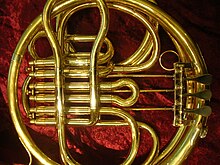Viennese horn
The Vienna horn is a brass instrument with three valves , a special design of the French horn . It is a simple F horn and has a narrower scale than the double horn . The Viennese horn has more partials and therefore generally sounds “brighter” than a double horn (“Although the Viennese musician, when he speaks of his instrument, paradoxically always describes a 'soft' and 'dark' sound as the ideal sound! Such a sound has less Partials "). The Vienna Philharmonic , it is for the horn duty to the Viennese horn to master. It shapes the specific Viennese sound style .
description
The tube length of the Viennese horn is around 3.7 meters from the mouthpiece to the end of the bell.
The Viennese horn usually has pump valves and not, like French horns, rotary valves (the designation Viennese horn also refers to F horns with rotary valves, which, in contrast to the French horn, have a smaller length of max. 11 mm and a removable bow). The valve most commonly used on the Wiener Horn is a double pump valve . Due to the position of the valves, its mechanism favors soft ties in legato played notes, so that the notes flow smoothly into one another.
As comparative studies by Gregor Widholm have shown, the special tonal characteristics of the Viennese horn result from its special design: the narrow scale length promotes the sound with a rich partial tone. The pipe length influences the energy requirement, the accuracy and indirectly the sound. Because of the higher energy requirements, passages with many staccato notes are particularly demanding on a Viennese horn player. In the high pitches, the lip tension has to be adjusted more precisely than with other horns in order not to "land" on an adjacent tip by mistake. Playing in the high register on the Vienna Horn therefore requires a little more concentration and better "functioning" of fine motor skills. The double pump valves enable smooth tone transitions, but make it difficult to make the tones sound clean in fast legato sequences; they can sound slightly fuzzy.
Manufacturer
The instrument maker Leopold Uhlmann (1806–1878) can be described as the “father of the Viennese horn”. Around 1830 he designed the pump valves so characteristic of the Viennese horn, which at that time were also known as "piercing box valves".
Other manufacturers are or were: Yamaha , Andreas Jungwirth, Haruo Kimura, Hermann Ganter, August Beyde (historical - mid 19th century), Anton Dehmal (historical - late 19th century), successor to Anton Dehmal (historical - late 19th century). Century - early 20th century), Karl Hoyer (Graz, vm. Late 19th century), Haagston, Jiracek & sons, productive cooperative of Viennese musical instrument makers (historical - 1st half of the 20th century), Wiener Hornmanufaktur, Robert Engel (historical - 2nd half of the 20th century), Ernst Ankerl, Gebr. Alexander, Daniel Kunst, Eduard Kiefl, Engelbert Schmid, Curia Brass.
Virtuosos
The most important virtuosos on the Vienna horn include: Lars Michael Stransky , Wolfgang Tomböck , Thomas Jöbstl , Günter Högner , Roland Berger , Josef Veleba , Josef Schantl , Karl Stiegler , Gottfried von Freiberg , Ronald Janezic and Josef Reif .
The Wiener Waldhornverein and its members are closely connected to the history and tradition of the Vienna Horn .
literature
- Kurt Janetzky , Bernhard Brüchle: The horn. A short chronicle of his development and work (= Our musical instruments. Vol. 6). Schott, Mainz 1977, ISBN 3-7957-2344-2 (and later editions).
- Ernst Paul: The horn of the Viennese sound style . In: Austrian music magazine. 24, Jg., Heft 12, 1969, ISSN 0029-9316 , pp. 698-702 (reprinted in: The Horn Call. Vol. 3, No. 2, 1973, ZDB -ID 1260009-x , pp. 29-32 ).
Web links
- www.wienerhorn.com (The meeting point for friends of the horn sound, Forum, Günther Vlaschits)
- Special features of the Vienna Horn (Vienna Symphonic Library - vsl.co.at)
- Thomas Jöbstl : Influence of the musician and the instrument on the Viennese horn sound (2000) (PDF, 11.4 MB) (Institute for Musical Acoustics - Wiener Klangstil (IWK) / University of Music and Performing Arts Vienna - iwk.mdw.ac. at)
- Gregor Widholm: Acoustics and technical characteristics of the Viennese horn (1989) (PDF, 5.2 MB) (iwk.mdw.ac.at)
- Gregor Widholm: The Vienna Horn - a historic relict successfully used by top orchestras of the 21st century (2005) (PDF, 391 KB, engl.)
- Scottish Vienna Horns (Engl.)
Remarks
- ^ Gregor Widholm: Das Wiener Horn ( Memento from June 24, 2002 in the Internet Archive )
- ↑ With the double horn the musician can choose between two instruments by operating the switch valve: he can choose the F horn with 3.7 m or the "B" horn with a shortened tube length of about 2.7 m. With the triple horn , the musician has a total of three "instruments" at his disposal: the F-horn, the slightly shorter B-horn and a "high F-horn" with a tube length of around 1.8 m.

